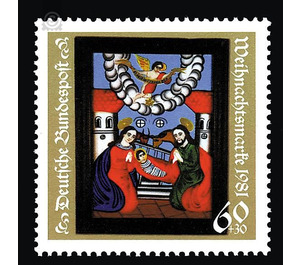Christmas - Germany / Federal Republic of Germany 1981 - 60 Pfennig
| Country | Germany / Federal Republic of Germany |
| Issue Date | 1981 |
| Face Value | 60.00 |
| Color | multi-colored |
| Perforation | K 14 |
| Printing Type | Six-color offset printing |
| Stamp Type | Postage stamp |
| Item Type | Stamp |
| Chronological Issue Number | 986 |
| Chronological Chapter | GER-BRD |
| SID | 266744 |
| In 38 Wishlists | |
Reverse glass painting, an important branch of folk art since the 18th century, goes back to late antiquity. Her oldest technique is gold etching. Gold leaf foil was applied to glass, the motif scratched out and backed with a layer of paint. Already over 2,000 years old slices from Syria are early preforms. Over the centuries, technology has changed very little. One of the most recent back glass techniques is glass printing, especially common in the previous century in England. The now popular old billboards are an example of mirrored glass prints. Reverse glass painting is something other than stained glass. While in glass painting, the applied colors are fused with the glass at high temperature and only in translucent light to develop their beauty, as seen in church windows, the Hinterglasmalerei uses opaque, usually brightly colored colors, which are often backed with metal foil to a achieve dazzling effect. The motifs are also reversed applied to the glass. The refractions of the striking light in the colorful colors make the charm of the reverse glass painting. After the first well-known Roman gold etchings from about the middle of the 3rd century AD, figurative depictions of biblical themes can be found since about the 14th century. Over the next two centuries, there are a number of Italian reverse-glass paintings, especially burial plates for altars and reliquaries, devotional images, pendants, medallions. The works were, mostly deposited with gold, made precious. Italy is also the starting point for the first serial production in the 16th century, along with popular simplification of the drawings. Medieval reverse glass painting was not limited to Italy alone. From the monastery of Doberan on the Mecklenburg Baltic coast, the earliest German reverse glass paintings, created in the first third of the 14th century. Folk art was the reverse glass painting with the beginning of the 18th century. In Augsburg an important center was formed. It produced folkloric images from the bourgeois-crafts area. In the second half of the 18th century, the reverse glass picture spread over much of Europe to Eastern Europe and Spain. The onset of serial production was closely linked to the location of the glassworks until the last century. Cheap glass was an important prerequisite for inexpensively producing such large quantities of reverse glass images. Especially in Silesia, Bohemia and the Bavarian Forest are workshops. Some of them come to the incredible numbers of 30-40,000 glass pictures annually. The beginning of industrialization and the proliferation of cheap color prints brought the end of folk back glass painting. She experienced a brief revival by the painters of the artist community »Der Blaue Reiter«. There are such famous names as Wassily Kandinsky, Paul Klee, Franz Marc, August Macke and Alexey von Jawlensky. They created reverse glass paintings - Kandinsky alone in the years 1909 to 1914 - and they made sure that museums, local historians and collectors of reverse glass painting took care of themselves. The painter village Sandl in Upper Austria was an important place of the Hinterglasbildkunst and one of the most productive producers. The term "Sandlbild" was in Upper Austria synonymous with Hinterglasbild. The back glass painting »Birth of Christ« also comes from Sandl. The Christmas stamp should help to make this beautiful old folk art not completely forgotten.


